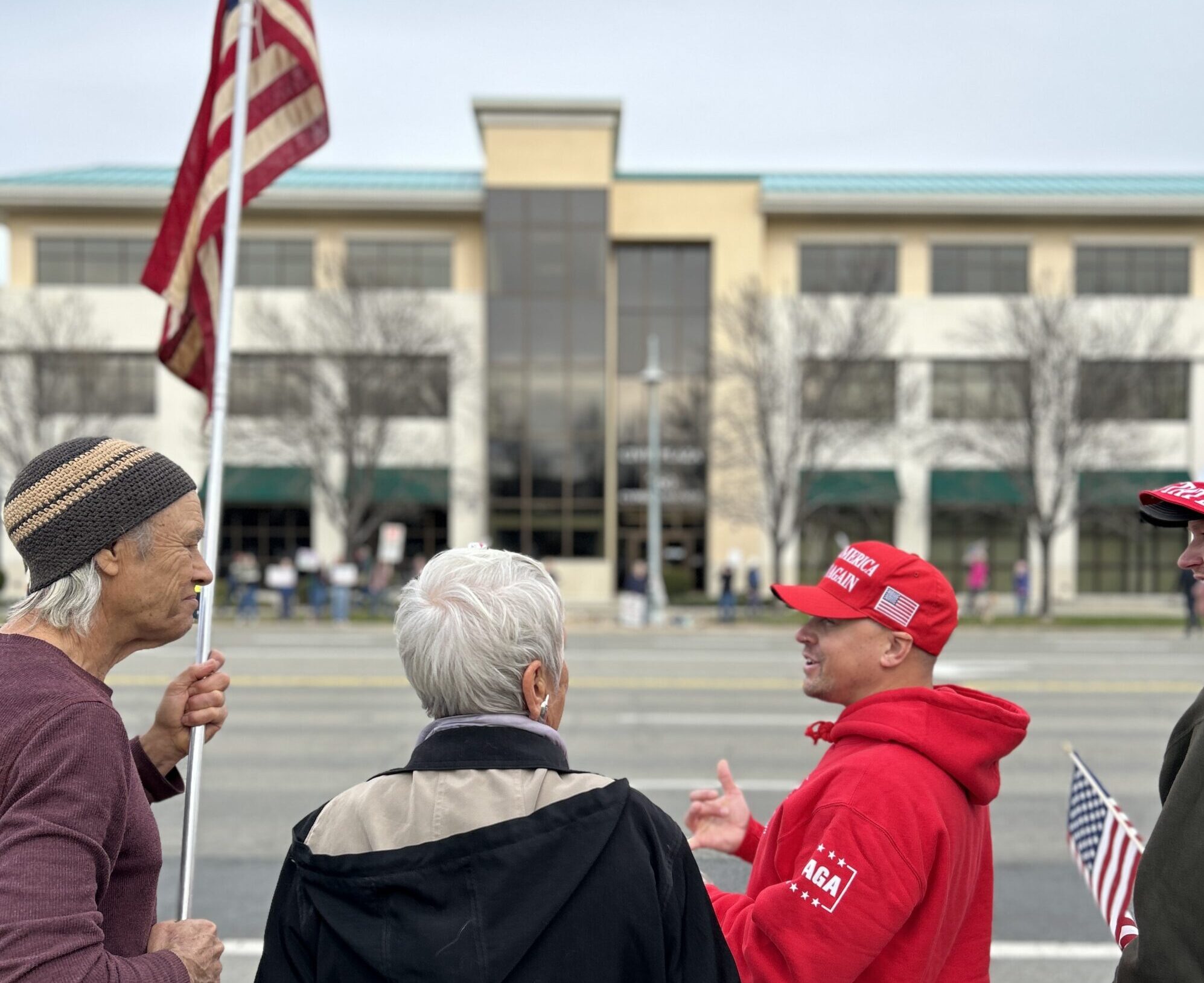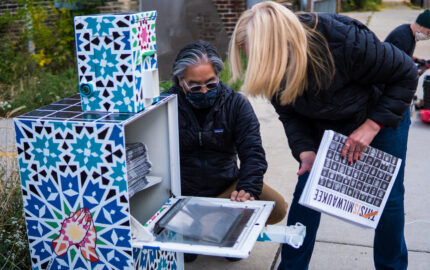In the far-right stronghold of Shasta County, California, journalist Annelise Pierce’s work has made her a target.
Pierce runs Shasta Scout, a small nonprofit newsroom she founded to bring independent reporting to the Northern Californian county where she lives. It’s a place where local law allows permit-carrying residents to attend county board meetings armed, where readers send her threats online, and where others work to undermine her reporting in a variety of ways. Recently, a YouTuber who goes by the handle Shasta Anon posted a video online containing photos of Pierce’s children and other personal photos and details about her life. The video has since been taken down.
“It kind of leaves you with this ongoing feeling of anxiety about what might be visible about you out there in the world,” Pierce said. “It’s really just meant to intimidate us away from the work we do.”
Pierce said she feels she is not alone, and that journalists — especially women and reporters in rural areas — face increasing threats while covering the presence of extremism in their communities. Despite the risks, reporters are on the ground across the country, covering what has become an ingrained feature of American politics. They do so by building trust with sources, some of whom may hold views that could endanger a reporter’s safety.
“What we’re seeing today is the consequence of a years-long effort to mainstream right-wing extremism,” said Jonathan Lewis, a research fellow at George Washington University’s Program on Extremism. “These ideas and narratives that motivate extremists have escaped containment.”
More than 40% of the nearly 12,000 journalists surveyed by the Pew Research Center in 2022 said they had experienced job-related harassment or threats at least once during the previous year.
The need for training in covering extremism is becoming more acute, as newsrooms are acknowledging a change in how reporters approach risk.
Safety training for reporters may once have been most relevant to conflict zones abroad, but media watchers say journalists increasingly need the same type of support in the U.S., as well as online. Covering extremism isn’t only about reporter’s safety, those who cover the topic say. It’s also about finding ways to cover these issues with nuance and to do so carefully, in order to avoid falling into traps, such as extremists using the media to amplify messages of hate.
Reporters and editors who cover this beat say it requires an ability to understand the ideological motives behind extremism, without normalizing them; the ability to avoid labeling, and a lot of trust-building with sources. Without understanding these nuances, experienced reporters say, there’s a risk of reducing extremism to individual pathology — it’s about networks, not lone wolves.
With the right tools, journalists and newsrooms can better equip themselves mentally and physically to cover right-wing extremism in the U.S., and remain resilient in the face of one of the most challenging reporting assignments of our time.
Covering a complex beat with nuance
Dana Coester is the founder and editor-in-chief of 100 Days in Appalachia, a collaborative newsroom that focuses on the stories of the Appalachian region. The outlet was founded in 2016 to cover the first 100 days of Trump’s first administration, as well as stories that challenge misrepresentations about the Appalachian region and its people.
While covering the culture and politics of the region, Coester said, the newsroom found itself at the epicenter of a resurgent white supremacist movement. After the first 100 days, they felt there was a need to continue this type of coverage.
Coester emphasizes to reporters the need to understand all the different extremist networks, their beliefs, and where they are meeting, and encourages them to show up in these spaces.
“Don’t focus on individual pathology. What are the networks?” she said. “We really resist the ‘lone wolf’ actor which the media tends to use. Stop doing that.”
Understanding the networks and interconnections between movements and individuals means that any time Coester reads about an act of violence by a young person who writes a manifesto, her experience reporting on extremists groups helps her immediately deduce what network of influence the individual comes from.
Jesselyn Cook, a 2025 Harvard Nieman Fellow, researches online subcultures and recently published a book called “The Quiet Damage,” highlighting stories of how radical conspiracy beliefs have torn families apart.
In reporting for her book and in her other work, Cook has developed techniques for interviewing and reporting on extremism, conspiracy theories, and radical movements. “With each new outreach I would make, I would try to go into it with an open mind and good faith,” Cook said. “Going in with that kind of approach gave me a lot more success in getting people to talk to me. But I will also say it’s a really delicate balance, because you need to be open-minded, but also very cautious.”
Coester said her staff at 100 Days in Appalachia is encouraged to take an empathy-based approach when covering communities.
“Don’t focus on individual pathology. What are the networks? We really resist the ‘lone wolf’ actor which the media tends to use. Stop doing that.”
— Dana Coester, founder and editor-in-chief of 100 Days in Appalachia
It’s not a matter of just showing up in these spaces and saying you’re investigating these groups, but demonstrating that you are also part of the community, and that you understand the key issues your neighbors are facing. If you show up and be curious, Coester said, you’ll leave with more insight and access to what is going on.
For example, Coester said she’s attended meetings of far-right members of makeshift militias where people are armed. But, she notes, they’re often also discussing drug addiction and the people they’ve lost in the community.
“You can see when you’re physically in that space the underlying issues that contribute to susceptibility,” she said. “And that’s really what we’ve tried to empower local reporters to do.”
To avoid perpetuating stereotypes, Pierce said she wants militia members in her community to know that she respects them as individuals, but is concerned about vigilante justice. If she’s referencing militia affiliation in a story, she added, she’ll explain what the militia is, but will also include other details so the source doesn’t seem one-dimensional.
“If they treat neighbors with kindness, document that too,” Pierce said. “We are all complex, multi-faceted people.”
Pierce added she avoids labeling people or classifying them into specific camps too quickly. For example, her staff avoids using the word “extremist” in their work, because readers can interpret that label differently. Instead, they describe people’s actions and beliefs and measure them against a neutral standard, such as the law.
“We ask political candidates, ‘Will you commit to following state law?’” Pierce said. “The answer to that question tells readers a lot.”
Tips and tools for covering extremism
Pierce grew up in a religiously conservative family where, she says, education for girls wasn’t highly prioritized. Always a voracious reader and writer, Pierce never took more than one English class, and didn’t attend journalism school. And yet, she reports on her community as any more experienced journalist would — and, arguably, under more challenging circumstances.
Pierce was inspired to pursue journalism when she joined a local grand jury that performs an independent watchdog function over local public agencies. She learned about the legal process, using public documents, and how to conduct interviews and verify facts. This fueled her interest in journalism and she started freelancing for a local news blog. Covering the George Floyd protests, she met armed counter-protesters associated with a local militia.
The experience taught her how to report in a dynamic environment and keep herself and her fellow reporters safe in the presence of armed militias. She took videos, and used them as reference tools to figure out what people were wearing, if there were weapons present, what conversations were happening, and the overall mood of the crowd. She spoke with everyone, including law enforcement and counter-protesters, asking them hard questions while remaining friendly.
Out of that experience, Pierce now provides for her small but growing newsroom — two full-time staffers and one part-timer— logistical training around events, such as elections. She also has worked with security experts to analyze blueprints of areas reporters will be working in to create escape plans.
“As journalists, there’s an expectation that we have for ourselves that we are imperturbable. We can’t be scared,” Pierce said. “You may be able to project outer calm, but there is a cost to your nervous system, your emotional and mental well-being, and physical well-being — and that of your family.”
Others who do this kind of work, such as the author Cook, also recommend locking down social media profiles to private accounts and using programs like DeleteMe to remove personal data from the internet. She also brings another person, sometimes her husband, to in-person interviews. She makes these parameters clear to her sources before meeting them.
Internationally, a UNESCO survey reported 73% of women journalists had faced online threats. Of those respondents, 20% have been abused and attacked offline in connection with the online threats.
For former Huffington Post reporter Rowaida Abdelaziz, the stakes of not being cautious about your digital presence are even higher.
“Being a visible Muslim woman covering Islamophobia has subjected me to an array of hatred, violence, and threats, both in the digital space and in the real world space,” Abdelaziz said. “That's the scariest form of all, when the digital space translates into real world threats of safety.”
She is careful in such cases to take care of her own mental health — something experts say is essential to enabling reporters to continue doing their work effectively, especially covering difficult beats such as extremism. In Abdelaziz’ case, she got offline and traveled for several days after publishing a contentious story about Hindu nationalism.
“When I’m publishing something I like to balance it out with going into the real world,” she said. “The kids say, ‘touch grass,’ I literally go and touch grass.”
Abdelaziz also leans on connecting with loved ones as well as other journalists of color and Muslim journalists. When things get serious, she said she receives professional help with a Muslim therapist who understands the media space.
“No story is worth your life,” Abdelaziz said. “At the end of the day, you are the person going home to your family. You are the person whose name is going to be on that byline. And so you want to make sure that you are doing whatever that you can do to protect yourself.”



